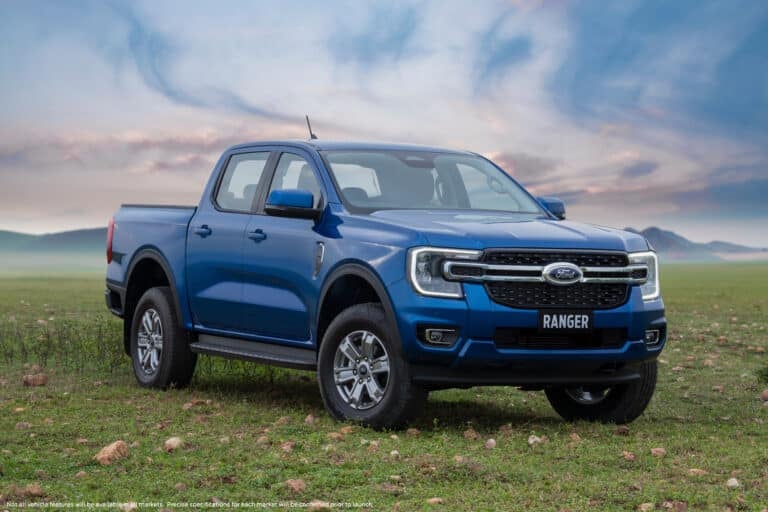The Toyota Prado has long been Australia’s top-selling large SUV, but for those who tow heavy caravans, it has fallen short of the mark with its rather small 2500kg towing limit. Late last year, as part of an update for MY18, the Prado got an extra 500kg added to its towing capacity.
The Prado update also included a face-lifted front, rear, new dash, and some important safety features like pre-collision safety system (PCS) with autonomous emergency braking and pedestrian detection, active cruise control (ACC), lane departure alert and auto high beam. All Prado auto models get this safety gear – previously, PCS and ACC were only available on the top-shelf Kakadu.
The reinvigorated Prado also has a new bonnet and front guards that curve down more to allow a better view of the road, plus a new grille, headlights and bumper. The bumper has been redesigned in order to allow a better off-road approach angle.
Looking at the rear, there are new taillights and a smaller garnish incorporated within the number-plate surround.
The GXL auto also now has Bi-LED head lamps, LED DRLs with ‘follow me’ function, LED fog lights and sun-visor light, rear differential lock, Optitron instrument backlighting and colour multi-information display as standard.
There have been some price reductions across most of the range, the largest cut being $1200 off the price of the GXL manual (now $59,990) and the GXL auto (now $62,990).
The Prado GXL auto we tested was fitted with the optional Premium Paint ($550) and Premium Interior ($3500), which adds leather trim, power-operated front seats, ventilated and heated front seats and heated second-row seats, making for a $67,040 vehicle (plus on-road costs).
The thing that we’re most interested in though is the increase in towing capacity. It’s now 3000kg, 300kg of which can go on the tow ball. The catch is that the towing capacity increase is for auto only – manual versions are still limited to 2500kg (with 250kg maximum on the tow ball).
This of course finally puts Prado line ball against its main competitors: the Ford Everest, Holden Trailblazer, Mitsubishi Pajero Sport and Isuzu MU-X.
It’s a bit of a step up into the Prado but the side steps and grab handles make it less of a chore. Driver vision is good out to the front and sides (although you don’t really notice any marked improvement in vision with the new guards and bonnet), but it’s blighted to the rear by the spare wheel mounted high on the tailgate. At least there’s a rear-view camera, but it’s not ideal … more on that later.
The front seats are well-bolstered and supportive but the second and third rows are pretty flat. That’s actually not a bad thing if you’re fitting child seats, as they are much easier to secure than on a heavily bolstered rear bench. For those not needing child seats – well the seats are not all that supportive, but at least there’s plenty of leg and head room.
As for the third row, this is a space for a couple of kids only; the seats are positioned close to the floor and there’s not much foot room.
The cargo space is generous with the third-row seats folded, but the side-opening tailgate is old school, as is the door-mounted spare wheel. The tailgate is heavy and difficult to open on cambered roads and the spare is high and heavy, so changing a flat tyre is a bit of a workout.
The 2.8-litre 1GD-FTV engine is smooth and fairly quiet for a diesel. While it provides strong shove in the back in its 2000-2500rpm band, it does have the usual turbo lag at low rpm. It wasn’t as bad as some turbo-oilers though, and you could anticipate the lag.
There are some European diesels that rev as freely as a petrol, but this isn’t one of them. The 2.8-litre was reluctant to rev past 3800rpm (redline is at 4400rpm) but all its power and torque has already happened well before then anyway. There’s no point trying to squeeze any extra revs out of it.
The six-speed auto got through the gears smoothly enough, and the full-time 4WD system gave good grip even on slippery surfaces, rarely engaging traction control.
The Prado is one smooth-riding 4WD, absorbing bumps well while being controlled with it.
Steering is light and direct but doesn’t have a lot of feel to it. We towed a 2800kg Olympic Javelin X8 that we borrowed from RV Connection in St Marys, NSW. The Olympic’s tow ball download was 200kg.
While rear cameras have made backing up to a caravan a much easier proposition, the Prado’s camera isn’t among the best. The camera doesn’t take in the tow ball, so you can line up to the coupling by watching the screen. While there is a graphic overlay on the reversing screen, the centre notch marker of this overlay doesn’t actually line up with the tow hitch.
With the van coupled, the Prado rose just 14mm at the front while rear sag was 35mm.
Settling into a 100km/h cruising speed on the freeway, the Prado wasn’t pushed around at all, but give the steering wheel a nudge and you’d get a yawing motion quite quickly. You’d have to consider a weight distribution hitch or an anti-sway friction device to keep the rig settled on the road if you’re towing this kind of weight. Ride quality remains very good, with none of the pitching that happens with some other 4WD wagons when towing.
Left to its own devices, the auto transmission hunts a bit as it’s not happy to settle in sixth gear for long even on fairly flat terrain. You’re better off not towing such a weight in overdrive anyway (because you risk overheating the transmission) so the only option really is to shift over to Sport mode, which locks out the (overdrive) fifth and sixth gears. At 100km/h in fourth the engine is spinning at a fairly high 2600rpm.
Towing at those revs with the weight we had behind it makes the Prado thirsty. When allowing the transmission to slip into fifth and sixth (on downhill sections of the highway), fuel consumption averaged 18.5L/100km. While towing in Sport mode only (so in fourth gear) and with some hill-climbing thrown in, fuel consumption was 20.2L/100km.
At least the Prado’s 150-litre fuel capacity helps ease range anxiety when touring in remote areas. You’d get at least 700km of towing in before you’d worry about finding a fuel stop.
It’s no surprise really that the Prado’s towing performance isn’t as good with a heavy van behind it. When pulling a 2200kg van it feels like it’s doing it pretty easily – but with a 2800kg, not so much. You’re not foot to the floor all the time to keep it going, but it runs out of puff quite easily on inclines.
Verdict
It was pretty clear that with a 2800kg van behind it, the Prado didn’t feel glued to the road. If you’re towing within the Prado’s new-found towing capabilities, you’re going to notice its diminished towing performance and higher fuel consumption too. That being said, this is a really comfortable touring vehicle (that isn’t too big for city work) and one with excellent fuel range.












